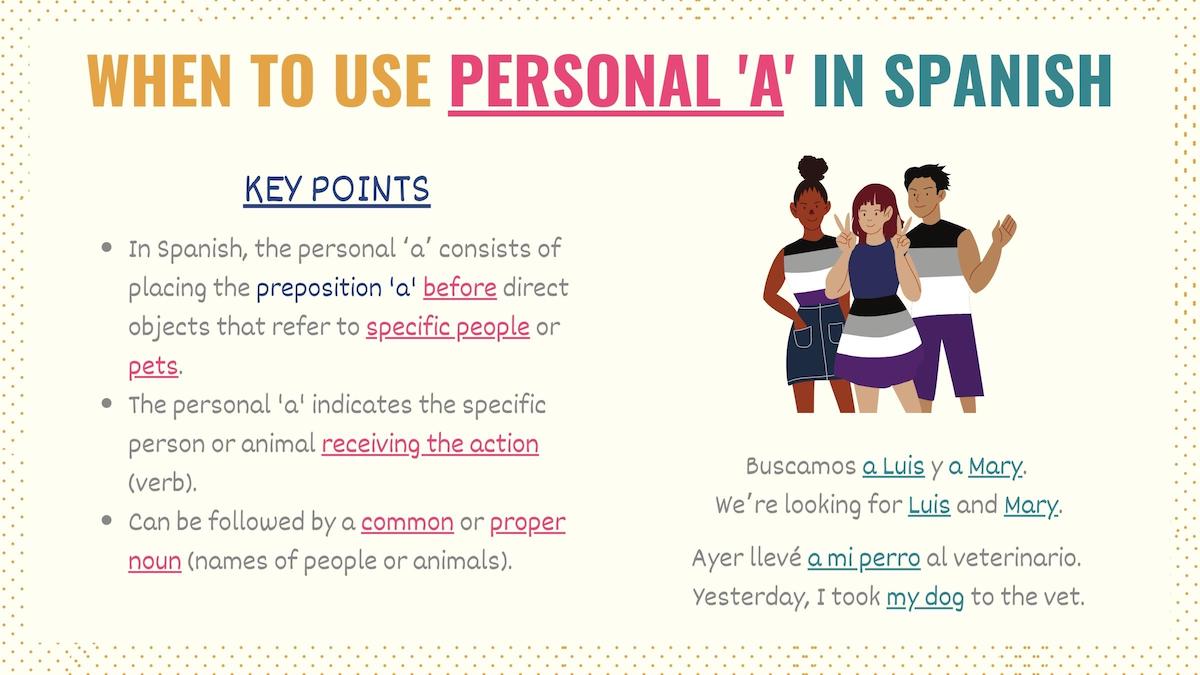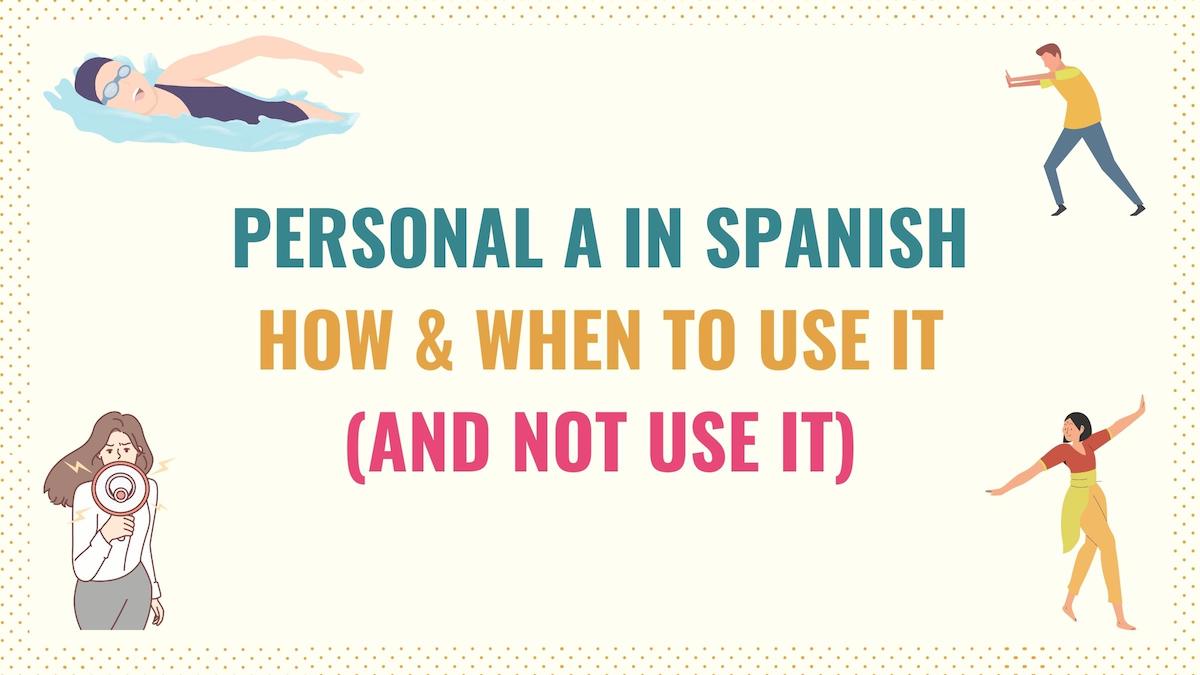Have you ever wondered why some Spanish sentences have an extra a before people or pets and why this word has no English translation? Even though it’s never translated, the personal a in Spanish is required to form complete and accurate sentences.
Since this is such an important part of Spanish grammar, in this guide, we’ll go over:
- What is the Personal A & When to Use it
- List of Spanish Verbs that Use the Personal A
- Key Points
- What To Do Next: Spanish Resources
Although the Spanish personal a is not included in translations, it’s a crucial structure you must understand and know how to use. So, let’s get down to business!
When to Use Personal A in Spanish
In Spanish, the personal ‘a’ consists of placing the preposition a before direct objects that refer to specific people or pets. In other words, you must use personal ‘a’ to indicate the concrete person or animal receiving the verb’s action.
Here are some sentences:
[Verb conjugated] + a + (determiner) + [noun]
Buscamos a Luis y a Mary.
We’re looking for Luis and Mary.
Ayer llevé a mi perro al veterinario.
Yesterday, I took my dog to the vet.
¿Por qué dejaste a Cindy sola?
Why did you leave Cindy alone?
Judith está cuidando a la bebé.
Judith is watching the baby.
The Spanish personal ‘a’ can be followed by proper nouns (names of people or places) or common nouns that refer to specific people or animals. Since these are specific entities, you must use concrete determiners such as possessives and definite articles.
It’s important to note that, when it comes to animals, the personal a in Spanish is not exclusive to pets. In fact, we must use this structure when talking about a specific animal:
Los niños ven al león.
The kids look at the lion.
El encargado del zoológico alimenta a las jirafas.
The zookeeper feeds the giraffes.
Check the previous sentences. To simplify pronunciation, the definite article ‘el’ is combined with the ‘personal a’ in Spanish to form the contraction ‘al’.
Take Note: Direct objects in Spanish are the receivers of the action in a sentence, you can find these objects by answering the question ‘who?’ or ‘what?’ is being acted upon.

Spanish personal a with pronouns
As you may already know, Spanish pronouns are words we use to replace the noun in a sentence. Some pronouns that work with the personal a are:
- Interrogative words quién and cuánto.
- Prepositional pronouns, such as ‘mí’, ‘ti’, ‘ella’.
- The indefinite pronouns alguien and nadie.
[Personal a] + [pronoun]
¿A quién estás viendo?
Who are you watching?
Estamos esperando a alguien.
We’re waiting for someone.
Entiende que Joe la ama a ella.
Understand that Joe loves her.
No conozco a nadie que hable chino.
I don’t know anyone that speaks Chinese.
Notice that, even when using pronouns, the Spanish personal ‘a’ is still replacing a person working as the direct object of the sentence.
When not to use personal a
The personal a in Spanish is not required when the direct object refers to a place, thing, or unspecified animal.
[Verb conjugated] + [determiner]+ [noun]
No conozco este lugar.
I don’t know this place.
¿Dónde dejaste las llaves?
Where did you leave the keys?
Celia está escribiendo una carta.
Celia is writing a letter.
Ellos quieren un perro pequeño y tranquilo.
They want a quiet and small dog.
Spanish Verbs that Use Personal A
Here is a list of Spanish verbs that use personal a:
- Acompañar: To accompany
- Admirar: To admire
- Amar: To love
- Bañar: To shower
- Buscar: To look for
- Conocer: To meet / To know
- Cuidar: To take care / To watch over
- Dejar: To leave
- Empujar: To push
- Encontrar: To find
- Engañar: To cheat / To trick
- Escuchar: To listen to
- Esperar: To wait
- Invitar: To invite
- Limpiar: To clean
- Llamar: To call
- Llevar: To take
- Peinar: To comb / To brush
- Querer: To love / To want
- Saludar: To waive / To greet
- Ver: To see / To watch
- Visitar: To visit
Yo quiero mucho a mis papás.
I love my parents very much.
Mi mamá lleva a los niños a la escuela.
My mom takes the kids to school.
Deberías invitar a Paulina y a sus amigas.
You should invite Paulina and her friends.
Key Points
Omitting the personal a in Spanish leads to forming incomplete sentences and affects your fluency. Here are some essential points you must keep in mind:
- The personal a in Spanish is used in sentences with direct objects.
- As its name suggests, the Spanish personal ‘a’ introduces a concrete person or animal who is receiving the action of the verb.
- It can be used with common nouns (niño, señora, mamá) as long as they refer to specific people or pets.
- The contraction al is the result of combining the preposition ‘a’ with the definite article ‘el’. Use this contraction when the personal ‘a’ is followed by this article.
- The personal ‘a’ in Spanish is not used when the direct object refers to places, things, or unknown animals.
- Many Spanish transitive verbs use this grammatical element.
Personal A Spanish Additional Resources
The word ‘a’ is one of the most common Spanish prepositions. In this guide, you learned how to use it with direct objects. However, like other prepositions, it has more useful applications. So, make sure you understand how to use it. Here are your next steps to master this topic.
Understanding what direct objects are and how to find them is indispensable to mastering the personal a in Spanish. So, click on the previous link to learn more about this topic. Some verbs require a direct object to have meaning. Since some of them work with the personal ‘a’, you should check what Spanish transitive verbs are and how to use them.
Download the Personal A in Spanish PDF
Grammar topics like the Spanish personal a aren’t always difficult to understand, but can take time to become comfortable with and implement. Feel free to download a copy of the PDF for this guide with all the rules on when to use and not use the personal a as well as examples of how it’s used in Spanish.



